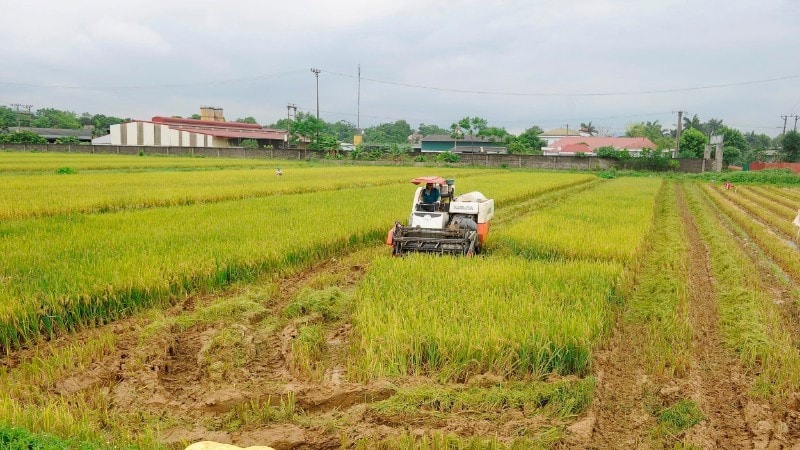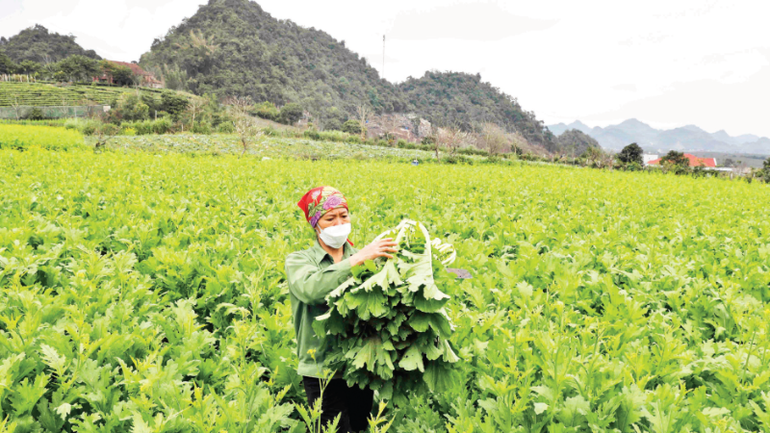
Director of Phat Tai Agricultural Cooperative, Chau Thanh Commune (Vinh Long Province) Tran Van Chung said: In the summer-autumn crop of 2024, the cooperative will start piloting rice cultivation according to the project "Sustainable development of one million hectares of high-quality and low-emission rice cultivation associated with green growth in the Mekong Delta by 2030" (Project) on an area of 48.4 hectares with the OM 5451 rice variety, attracting the participation of nearly 50 households.
When participating in the model, the authorities guide on how to alternate flooding and drying, how to manage nutrition, use seeds, fertilizers, and pesticides properly, as well as skills in managing and using straw effectively. This has brought about clear results, each hectare of cluster sowing only needs 60-70kg of seeds, and row sowing from 100-120kg compared to the traditional method, which requires an average of 200-220kg of seeds per hectare. At the end of the season, input costs are reduced, productivity is increased, and especially emissions are greatly reduced.
According to Deputy Director of the Department of Crop Production and Plant Protection ( Ministry of Agriculture and Environment ) Nguyen Thi Thu Huong, the application of emission-reducing farming processes such as alternate wetting and drying (AWD), integrated nutrient management, organic farming, precision agriculture and climate-smart agriculture has significantly reduced the amount of agricultural inputs such as chemical fertilizers, pesticides and irrigation water. Thereby, reducing production costs and increasing profits for farmers.
Specifically, in the models, methane emissions were reduced by an average of 30-45%, irrigation water was saved by 20-30%, while significantly saving seeds, fertilizers and reducing the number of times pesticides were sprayed, helping to reduce input costs by 5-10%, thereby increasing farmers' income by 10-20%.
Besides rice, other crop groups such as corn, cassava, soybeans, vegetables, and fruit trees also have great potential to apply emission-reducing farming solutions. According to former Deputy Minister of Agriculture and Rural Development (now the Ministry of Agriculture and Environment) Le Quoc Doanh, emission-reducing crop production models not only solve economic problems but also are an important basis for our country to gradually approach and effectively participate in the carbon credit market, both voluntary and compulsory.

According to the Ministry of Agriculture and Environment, crop production is the sector with the largest amount of emissions in agricultural production, accounting for about 80% of the total emissions of the whole industry, mainly methane from rice production activities. Reducing emissions in crop production is part of our country's general policy of reducing net emissions to zero by 2050.
Although the agricultural sector has made many efforts in recent times, the cultivation sector is currently limited to a number of small-scale projects and programs that lack fundamental, systematic strategies.
Ms. Nguyen Thi Thu Huong said that the low-emission cropping system in Vietnam lacks a comprehensive national program; lacks clear incentive and financial support mechanisms; there are no national standards and criteria for “low-emission cultivation”. There is no standardized measurement, reporting, and verification (MRV) system, leading to difficulties in assessing actual impacts and difficulty in integrating into carbon credit mechanisms...
Faced with urgent practical requirements, the agricultural sector is developing a project to develop low-emission crop growing areas for the 2025-2035 period, with a vision to 2050. This project aims to reduce greenhouse gas emissions in the crop growing sector by at least 10% by 2030, contributing to a 30% reduction in methane compared to 2020; form at least 15 low-emission production area models and develop five technical packages for key crops such as: rice, corn, pepper, coffee, dragon fruit, banana, citrus fruit trees and perennial industrial crops.
The project also requires the construction of a system for measuring, reporting, assessing and database of emissions by ecological region to make the reduction process transparent, towards integrating carbon credits according to international standards...
Major agricultural markets in the world are tightening requirements related to carbon emissions, sustainability certification, traceability and environmental protection. Slow implementation of emission reduction production programs may make it difficult for Vietnamese agricultural products to export and reduce their competitiveness, especially in the context of deep economic integration and implementation of new-generation Free Trade Agreements (FTAs).
The Ministry of Agriculture and Environment is urgently reviewing and assessing the current status of greenhouse gas emissions from key crops, soon having a national strategy in this field; focusing on perfecting institutions, tools, and support policies...
According to the Ministry of Agriculture and Environment, crop production is the sector with the largest amount of emissions in agricultural production, accounting for about 80% of the total emissions of the whole industry, mainly methane from rice production activities. Reducing emissions in crop production is part of our country's general policy of reducing net emissions to zero by 2050.
Source: https://baolamdong.vn/huong-den-nen-nong-nghiep-xanh-ben-vung-390848.html





![[Photo] Prime Minister Pham Minh Chinh attends the groundbreaking ceremony of two key projects in Hai Phong city](https://vphoto.vietnam.vn/thumb/1200x675/vietnam/resource/IMAGE/2025/9/27/6adba56d5d94403093a074ac6496ec9d)



































































![[Live] Vietnam Tourism Awards Ceremony 2025](https://vphoto.vietnam.vn/thumb/402x226/vietnam/resource/IMAGE/2025/9/27/001400e8ad9a46e9a3651a828cc6834d)


































Comment (0)